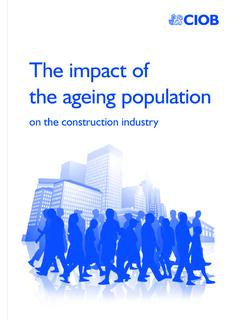Transcription of WHAT WAS THE IMPACT OF EUROPEAN TRADE AND …
1 WHAT WAS THE IMPACT OF EUROPEAN TRADE AND EXPLORATION ON THE SOCIETIES OF AFRICA, ASIA AND THE AMERICAS? Overview: The EUROPEAN nations of Spain, Portugal, England, France, and the Netherlands expanded through exploration and colonization during the 1600s and 1700s. These countries began making their colonial claims in Africa, Asia and the Americas. The EUROPEAN s quest for economic growth and territorial expansion greatly impacted the societies of Africa, Asia and the Americas. Document A: The Columbian Exchange (map) Document B: Native American Population 1492-1980 (graph) Document C: Slave TRADE (map) Document D: Slave Ship Diagram Document E: Francis Xavier Document F: The Black Ships (photo) Document G: Toytomi Hideyoshi Background Information The Effects of EUROPEAN Colonization on the Americas The motivation for EUROPEAN expansion was economically driven. Europeans built several types of colonies in the new world. There were different types of colonial structures built; trading posts, settlement colonies and plantations.
2 Among the nations building colonies in the New World were Spain, Portugal, England, France and the Netherlands. The EUROPEAN countries relationships with the Native Americans already living in the Americas were very different. The French established trading posts with the Native Americans in North America. They set up a fur TRADE with them and had a good relationship. However, in other parts of the Americas, Europeans treated the Natives much differently. The British, Spanish and Portuguese had a negative IMPACT on the Native Americans. They quickly developed plantation systems which depended on native labor, which would later be replaced by imported slave labor from Africa. The enslavement Native Americans often involved harsh punishment and horrible working conditions on the plantations. The plantations emerged in the Caribbean where sugar cane could be grown and sold as a valuable cash crop. The plantation system took place in Southern English Colonies where crops such as tobacco, rice and indigo were grown.
3 The English settlers pushed the Native Americans off their land in order to establish their settlements in the New World, with the no regard for the Natives. Perhaps one of the greatest impacts on the Natives American people was the diseases brought by Europeans to the New World. The Natives had never been exposed to all the diseases which were often found in Europe. American Indians contracted vicious Old World pathogens like smallpox and lacked the immunity to fight these diseases. The Native Americans began to die at a rapid rate. Many historians now believe that new diseases introduced after Columbus's arrival killed off as much as 90% or more of the Native American ESSAY QUESTIONS: 1. Which EUROPEAN countries created colonies in the New World? 2. Where did the Europeans focus on building colonies? 3. What was the relationship like between the French and the Native Americans? 4. How did the Spanish and Portuguese treat the Indians?
4 5. What were the Indians forced to do? 6. What were the cash crops grown in the colonies? 7. How did the British treat the Native Americans? Document A Source: Document Analysis: 1. What did the Europeans bring to the New World that negatively impacted the Native Americans? 2. Based on your understanding of the Columbian Exchange, how did contact between the Old World and New World IMPACT our lives today? Document B SOURCE: Native American Population in the Americas 1492 - 1980 Document Analysis: 1. How did the Native American population in the Americas decrease from 1492 to 1800? (in millions) 2. What event occurred in 1492 that eventually led to a drastic decrease in the Native American Population living in the Americas? 3. Making an inference, what were the main causes of death of the Native Americans? Background Information THE ATLANTIC SLAVE TRADE In Africa, economic and political influence was based on the slave TRADE which began as a result of the need for more labor (people to work) on the plantations in the Americas.
5 To acquire the slaves, the Europeans traded with the African tribes. Europeans would bring the African tribe leaders weapons, irons, cloth and horses in exchange for slaves. As the demand for slaves increased, tribal warfare (fighting) in Africa increased as tribes began capturing and trading members of other tribes in order to participate in this TRADE . Some tribes became very powerful through this process while most African societies suffered from the loss of workers being taken and traded to the Europeans. Families and communities were separated, and the major population decrease and loss of workers led to economic problems in Africa. The Atlantic slave TRADE took place across the Atlantic Ocean from the 16th through to the 19th centuries. The majority of slaves transported to the New World were Africans from the central and western parts of the continent, sold by Africans to EUROPEAN slave traders who then transported them to North and South America.
6 The numbers were so great that Africans who came by way of the slave TRADE became the most numerous Old-World immigrants in both North and South America before the late eighteenth century. This was crucial to those EUROPEAN countries which, in the late seventeenth and eighteenth centuries, were competing with each other to create overseas empires. BACKGROUND ESSAY QUESTIONS: 1. What was Africa s main export? 2. What region of Africa did most slaves come from? 3. What IMPACT did the Atlantic Slave TRADE have on the population of Africa? 4. Why were slaves needed to work on Plantations? Document C: Source: Document Analysis: 1. From this map, what can you infer about the population of Africa after the slave TRADE ? 2. What part of the Americas had the greatest increase in African slaves? 3. What were the Africans doing once they reached the Americans? Document D Source: Document Analysis: 1.
7 What was the voyage like for the slaves coming to the New World? 2. What IMPACT did the harsh conditions of the Middle passage have on the Africans coming to the new world? Based on the diagram, what can you infer about the survival rate for the Middle Passage? Background Information The Spread of Christianity and Asian Isolationism In Asia, interaction was prompted primarily through TRADE and the beginnings of EUROPEAN colonization and expansion. As a region, Asia was distinctly different than the New World and Africa in that it possessed highly advanced, prosperous, relatively modern, and military strong civilizations. Because of these characteristics, EUROPEAN dealing with Asia were based more on an association of being equals. This equality prompted Europe and Asia to largely engage in an beneficial TRADE relationship. During most of the 1600s and 1700s, there was no significant EUROPEAN colonization in Asia comparable to that which existed in the New World.
8 However, Europeans still had a profound IMPACT on the society and culture of Asia. For centuries Asian civilizations had largely developed in isolation from one another and from the EUROPEAN world. With the opening and eventual expansion of TRADE relationships this tradition of isolation began to break down and the introduction of EUROPEAN ideas occured, especially the introduction of Christianity as missionaries began travelling with the EUROPEAN merchants. Because of this influence of Christianity, the many Asian governments limited or closed off TRADE with the Europeans and returned to isolationism in order to protect their cultures. BACKGROUND ESSAY QUESTIONS: 1. How did Asian societies compare to those in Africa and the Americas? 2. How did these differences affect the way Europeans dealt with Asians? 3. Why did the Asian Government limit contact with EUROPEAN culture? 4. How did Christianity spread in Asia?
9 Document E Source: From: Henry James Coleridge, ed., The Life and Letters of St. Francis Xavier, 2d Ed., 2 Vols., (London: Burns & Oates, 1890), Vol. II, pp. 331-350; reprinted in William H. McNeil and Mitsuko Iriye, eds., Modern Asia and Africa, Readings in World History Vol. 9, (New York: Oxford University Press, 1971), pp. 20-30. I am beginning to have great hopes that God will soon provide free entrance to China, not only to our Society, but to religious of all Orders, that a large field may be laid open to pious and holy men of all sorts, in which there may be great room for devotion and zeal, in recalling men who are now lost to the way of truth and salvation. I again and again beg all who have a zeal for the spreading of the Christian faith to help by their holy sacrifices and prayers these poor efforts of mine, that I may throw open an ample field to their pious Document Analysis: 1. Why would the spread of Christianity be seen as a threat by the leaders of China and Japan?
10 Document F Europeans Traveling to Asia THE BLACK SHIPS Source: the image above, what can you infer about Asian attitudes towards Western countries? Document G Source: The Edicts of Toyotomi Hideyoshi, Expulsion of the Missionaries 1587 Japan: A Documentary History: The Dawn of History to the Late Tokugawa Period, ed. Lu (Armonk, New York: 1997). The Padres (priests), by their special knowledge (of science and medicine), feel that they can at will entice people to become their believers (Christians). In doing so they commit the illegal act of destroying the teachings of Buddha prevailing in Japan. These padres cannot be permitted to remain in Japan. They must prepare to leave the country within 20 days of this notice. 1. Why do you think Japanese attitudes changed towards the Europeans by 1587? 2. Why do you think missionaries had to leave? Bucketing Getting Ready to Write: Directions: Look over all the documents and organize them into buckets.




